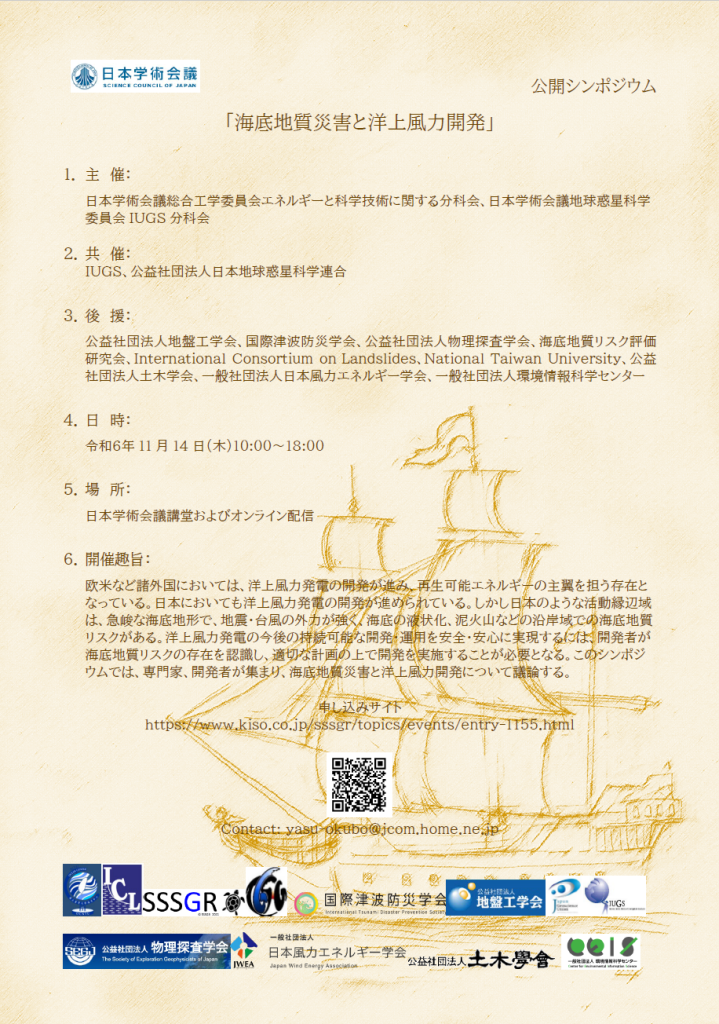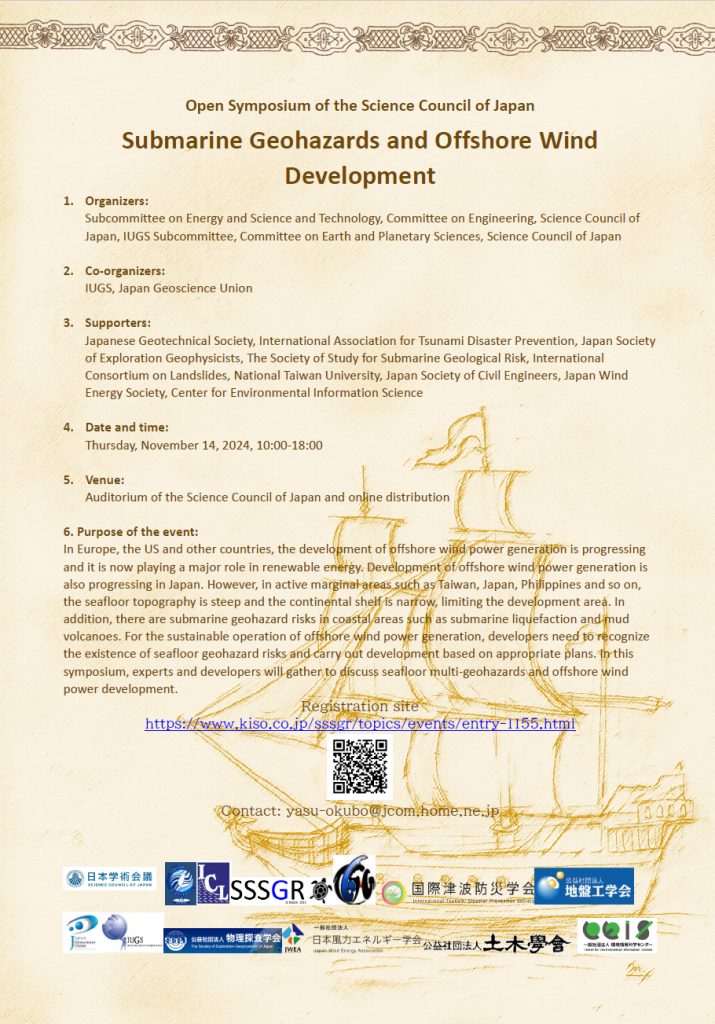2024.10.22
公開シンポジウム「海底地質災害と洋上風力開発」(2024/11/14)
会員の方より、公開シンポジウムのお知らせをいただきましたのでご案内いたします。
公開シンポジウム「海底地質災害と洋上風力開発」
- 主催:日本学術会議総合工学委員会エネルギーと科学技術に関する分科会、日本学術会議地球惑星科学委員会IUGS分科会
- 共催:IUGS、公益社団法人日本地球惑星科学連合
- 後援:公益社団法人地盤工学会、国際津波防災学会、公益社団法人物理探査学会、海底地質リスク評価研究会、International Consortium on Landslides、National Taiwan University、公益社団法人土木学会、一般社団法人日本風力エネルギー学会、一般社団法人環境情報科学センター
- 日程:2024年11月14日 (木) 10:00〜18:00 (Field Trip:11月15日、16日)
- 場所:日本学術会議講堂およびオンライン配信
- フライヤー


開催趣旨
欧米など諸外国においては、洋上風力発電の開発が進み、再生可能エネルギーの主翼を担う存在となっている。日本においても洋上風力発電の開発が進められている。しかし日本のような活動縁辺域は、急峻な海底地形で、地震・台風の外力が強く、海底の液状化、泥火山などの沿岸域での海底地質リスクがある。洋上風力発電の今後の持続可能な開発・運用を安全・安心に実現するには、開発者が海底地質リスクの存在を認識し、適切な計画の上で開発を実施することが必要となる。このシンポジウムでは、専門家、開発者が集まり、海底地質災害と洋上風力開発について議論する。
申込方法
こちらのサイトに掲載のウェブフォームよりお申し込みください。
次第
司 会
岩城智香子(日本学術会議連携会員)
10:00 「Opening remarks」
Hassina Mouri (IUGS President)
10:05 「開催趣旨」
大久保 泰邦(日本学術会議連携会員)
セッション1 Case Studies of Submarine Geohazard Events(コンビーナ:佐々 真志)
10:10 「海底ジオハザードリスクと洋上風力」
佐々 真志(国立研究開発法人海上・港湾・航空技術研究所港湾空港技術研究所)
10:30 「混濁流研究の最近の進展」
成瀬 元(京都大学)
10:50 「海底地すべり・津波研究の最近の進展」
「Recent Advances in Understanding Submarine Landslides and Tsunamis」
David Tappin(British Geological Survey)
11:10 「洋上風力施設における洗掘対策の最近の進展」
「Recent Advances in the Mitigation of Scour in Offshore Wind」
Andreas Roulund(Ørsted)
休憩(20分)
セッション2 Submarine Geological and Geophysical Data Archives
(コンビーナ:木戸 ゆかり)
11:50 「地形と地下断面・粒度分布などの既存データを用いた広域な地質傾向を念頭に置いた局所リスク評価の必要性」
佐藤 智之(産業技術総合研究所地質調査総合センター)
12:10 「海底地形データのアーカイブとハザード評価への活用 〜令和6年能登半島地震に係る海底地すべり及び海底活断層の把握〜」
南 宏樹(海上保安庁海洋情報部技術・国際課)
12:30 「Submarine Geological and Geophysical Data Archives」
Vicki Ferrini (Lamont-Doherty Earth Observatory, Columbia University)
12:50「Seabed2030 and Hunga Tonga-Hunga Ha'apai eruption bathymetry
expedition」
Kevin Mackay (National Institute of Water and Atmospheric Research)
昼食(60分)
セッション3 Requirements of offshore geological and geophysical surveys to
properly characterize submarine geohazard risks(コンビーナ:松島 潤)
14:10 「リスクと不確実性:物理探査を用いた地質評価を例にして」
松島 潤(東京大学)
14:30 「Required marine geological, geophysical and geotechnical surveys
for
offshore wind farm development in Taiwan」
Char-Shine Liu (National Taiwan University)
セッション4 Global review of submarine geohazard risks to offshore renewable
energy(コンビーナ:川村 喜一郎)
14:50 「熊野灘大陸斜面における海底ジオハザードの可能性:海底地滑り発生要因の考察」
金松 敏也 (国立研究開発法人海洋研究開発機構研究)
15:10 「Geological framework and possible geohazards in central Taiwan
Strait」
Jih-Hsin Chang (National Taiwan University)
15:30 「The experience of the Italian Marine Geology Research community
in standardized geohazard feature mapping on the Italian Seas」
Francesco Latino Chiocci (Geologia Marina Dipartimento Scienze della
Terra Università La Sapienza)
休憩(20分)
セッション5 International Capacity Building(コンビーナ:竹内 彩乃)
16:10 「The Aura Centre for Doctoral Training in Offshore Wind
Energy」Robert Dorrell (University of Hull)
16:30 「The Geology of Wind Power: from the second largest wind economy
in the mid-continent US to the offshore challenge」
Nicholas Hayman (University of Oklahoma)
16:50 「The Research Institute for Volcanology and Risk Assessment (IVAR)
and its
potential as a training platform」
José Manuel Pacheco (IVAR - Instituto de Investigação em Vulcanologia
e Avaliação de Riscos, Universidade dos Açores)
17:10 「パネルディスカッション:ガイドラインに向けて」
パネラー:佐々 真志、木戸 ゆかり、松島 潤、川村 喜一郎(山口大学)、竹内 彩乃(東邦大学)
17:50 「まとめと閉会のあいさつ」
益田 晴恵(日本学術会議連携会員)
Field Trip

- Date: 15 (Fri) and 16 (Sat) November
- Place: Miura Peninsula
- Guide: Yujiro Ogawa (Professor Emeritus, University of Tsukuba)
- Deadline for registration: 30 October, 2024
- Field observation:
- Miocene to Pliocene of accretionary prism along the Sagami trough plate subduction boundary. Sedimentary rocks derived mainly from Izu volcanic arc.
- Uplifted benches and coastal terraces due to subduction earthquake during recent 100 kyears.
- Evidence of various types of sedimentation and deformation due to accretionary prism formation, particularly by earthquakes, submarine landslides by discussion either liquefaction, fluidization, or diapirism. Many interesting structures are seen.
- People's life styles by fisheries and sightseeing, and preparedness.
